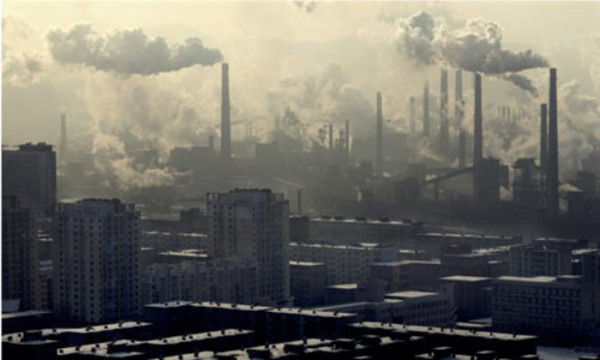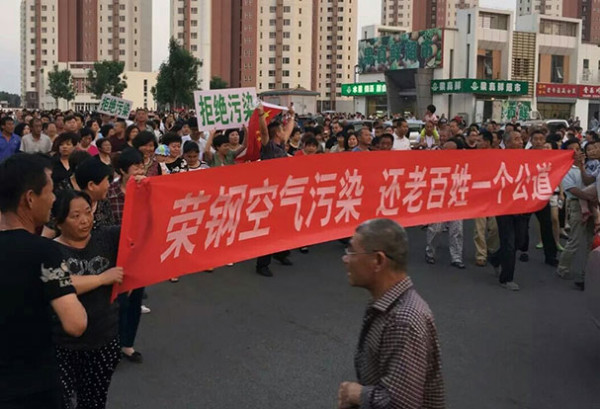The world’s biggest driver of climate change facing devastating environmental blowback
Dikang, chinaworker.info
As negotiators in Paris neared the final days of the UN climate summit in December, the Chinese capital was paralysed by a new pollution cloud that brought forth the first ever ‘red alert’ from city authorities. Half of Beijing’s private cars were grounded and schools, construction sites and some factories were ordered to close down. Local residents and pollution experts criticised the government’s slow reaction – pollution levels were even higher during the previous week’s ‘orange alert’ but fewer countermeasures were taken.
Chinese media reported that 27 other cities across northern China also elevated their pollution warning levels as toxic smog affected more than 300 million people. While the soot and smog that regularly descends upon Beijing and other Chinese cities are not the same as carbon dioxide emissions, the main cause of global warming, they come from the same source: coal and other fossil fuels. Coal accounts for over 60 percent of China’s energy output and despite the economic downturn, China’s heavy coal dependence is set to continue for decades unless a radical – revolutionary – change of direction occurs. So, Beijing’s ‘red alert’ is also a symbol of the crisis facing our planet.
During Beijing’s red alert, the Air Quality Index (AQI), which measures hazardous airborne particles, or ‘PM2.5’, at one point exceeded 600 – close to the level of toxicity in an airport smoking lounge. The World Health Organisation’s safety level is 25, but almost no Chinese cities come close to this level. Last year, only 3 of 74 major cities achieved the government’s less rigorous AQI targets, but all exceeded the WHO safety limit. Between 2008 and 2015, Beijing has averaged a daily AQI of 100, four times the WHO limit. Beijing’s mayor has previously said air pollution has made the city “unliveable” and yet the capital does not even rank in the top ten most polluted cities in China (last year Beijing was number 13).
Electric cars
With massive traffic and economic disruption from what is the third ‘smog attack’ in almost as many weeks, Chinese media report soaring interest from Beijingers for electric cars – which are not affected by the driving bans. China has invested more than any other government in ‘green alternatives’ and renewables over the past five years, including generous tax breaks and government support for electric car makers like Shenzhen’s BYD. But the environmental benefits of this investment are negated by the realities of the economic system and focus on ‘market solutions’. Electric cars, even when technical issues like recharging facilities and limited battery capacity are solved, still draw their electrical power predominantly from coal and other fossil fuels.
Decades of explosive but wasteful and environmentally destructive economic growth has meant that China accounts for two-thirds of the world’s increase in carbon dioxide (CO2) emissions since the year 2000. A recent government revision of China’s post-2000 coal consumption figures revealed an additional one billion tons of CO2 emissions that were previously unrecorded.

Climate threats
China’s dependence on fossil fuels to power its economy has become one of the biggest obstacles to halting the world’s march towards disastrous climate change – defined as an average temperature increase overstepping 2 degrees by the end of the century. Some facts highlight the scale of the problem:
- China produces and consumes almost as much coal – the dirtiest fossil fuel – as the rest of the world combined.
- In 2006 China overtook the United States as the number one emitter of greenhouse gases – last year its emissions were more than the US and EU combined.
But China is also the country most threatened by climate change. A 900-page report published by government experts on the eve of the Paris summit underscored this point. Among other things it reports that sea levels around China are rising faster than the global average, posing a threat to major coastal cities like Shanghai and Hong Kong, which are key drivers of the country’s economy. Massive infrastructure projects like the Three Gorges Dam and the world’s highest railway over the Tibetan plateau are threatened by increased rainfall and melting permafrost.
China already suffers a water crisis as home to 21 percent of the world’s population but with only 7 percent of the world’s freshwater supplies. The report warns the country’s water resources could shrink a further 5 percent by mid-century because of climate change. This threatens longer draughts in the dry season and more powerful storms in the wet season.
Popular backlash
China’s one-party dictatorship is already under massive pressure because of the growing popular backlash to choking air pollution, more than 500 confirmed “cancer villages” and toxic water supplies. According to the Ministry of Environment, 60 percent of China’s underground water and one-third of its surface water is unfit for human contact.
A surge in environmental protests has alarmed regime strategists, who see the potential for these to morph into broader anti-government movements. The number of pollution-related protests has more than doubled in the past three years.
This year in June, massive protests gathering over 50,000 people shook Jinshan, an industrial district of Shanghai, forcing the local government to halt construction of a ‘PX’ (paraxylene) petrochemical plant. “There is pollution in the air and pollution in the ground… The iron and steel plant is too close to our homes,” said a spokesperson for a similar protest in May, involving around 4,000 residents in Gegu township outside Tianjin. Also in Inner Mongolia, in April, yet another protest against a chemical plant, this time involving mainly ethnic Mongolian farmers, was brutally suppressed by 2,000 riot police using rubber bullets, gas and water cannon. Inner Mongolia and other minority regions such as Tibet and Xinjiang have seen a marked increase in environmental protests and these are fuelling nationalist sentiment, an explosive mix as far as Beijing is concerned.
China’s climate stance
The Chinese regime is also facing mounting economic problems, which force it to try to speed up a shift to cleaner higher-tech industries and a much bigger service sector. This is one reason why China’s representatives at the Paris summit are anxious for some form a global accord after the fiascos of recent years. The Economist magazine notes that an international climate treaty, like the WTO which China joined in 2001, can “help the government fight entrenched interests at home.”
Fundamentally, Beijing’s stance has not changed but it has become more sensitive to global and especially domestic pressures to talk ‘green’ more convincingly. The regime’s climate diplomacy is also shaped by its increasingly acrimonious conflicts with US capitalism over economic, trade and military issues. Like other governments, but maybe more so, Beijing wants to enhance its diplomatic profile at these climate talks.
As before, the Chinese regime only agrees to reduce its carbon emissions per unit of GDP, i.e. to slow the pace of expansion rather than reduce emissions. It has pledged that China’s carbon emissions will peak in 2030. Not only is this too little, too late, it is also vague, containing no absolute ceiling for emissions as demanded by many Chinese and international climate experts. Beijing also refuses any independent checks or controls. Despite this, for the most part the global media has praised the Chinese regime’s ‘new’ climate policy. This is part of a worldwide drive by the capitalist establishment to give the false impression of momentum towards climate solutions.

Green investments, but…
Despite announcing a number of seemingly bold environmental measures, the actions of the Chinese dictatorship do not match its words. Significant state-led investment in wind, hydro and solar power mean that China leads the world with 433 gigawatts of generating capacity from renewables – more than double the US in second place with 182 gigawatts (figures for 2014).
But much of this capacity is not used due to ‘curtailment’ or wastage. This results when regional power grids choose to access from coal-fired power stations rather than solar or wind farms. This can be due to cronyism in the energy industry, protectionism towards local coal-fired plants, but also the technical backwardness of China’s electricity supply grids which cannot cater for the increases in wind and solar output. The rate of wastage has risen in 2015, from 8 to 15 percent in the case of wind power. The slump in the global price of coal is an additional factor (a fall of 60 percent since 2011) making coal-fired power plants very profitable despite falling power consumption in a slowing economy.
The State Grid Corporation of China is the country’s biggest power distributor and the 7th biggest company in the world, according to the Fortune Global 500 list, with major investments in Australia, Brazil, Philippines and Portugal. It is also one of the biggest owners of coal-fired power plants in China and of course discriminates in their favour.
Coal power bubble
As in every other question, different entities ostensibly controlled by the Chinese state, face in different directions. While Beijing announces policies to promote renewables, provincial governments are authorising a massive expansion of coal-fired power capacity. According to a joint report by Chinese universities and Greenpeace, which warns of a “coal power bubble”, 155 new coal-fired power plants were authorised this year alone.
If these plants run at typical levels (coal-fired plants in China now operate well below full capacity), they would emit 560 million metric tons of carbon dioxide a year, reports The New York Times, “equal to Brazil’s total energy emissions”. The cost of this investment is US$74 billion, representing a threat to both the climate and China’s overstressed financial system.
“A few years down the road, we’ll see what a waste the plants are. We have seen this happen to the steel and cement industries,” says Zhang Boting, vice chairman of the China Society for Hydropower Engineering, who admittedly cannot be regarded as impartial.
The dictatorial regime, wedded to a ‘state capitalist’ model of development and beholden to the interests of billionaire cronies, is incapable of fundamentally changing course away from even more environmental destruction and even more debt. A socialist alternative is needed based on democratic public ownership and planning of the energy sector and all major corporations, alongside full democratic rights, an end to repression and censorship, and a government of the working class majority.




